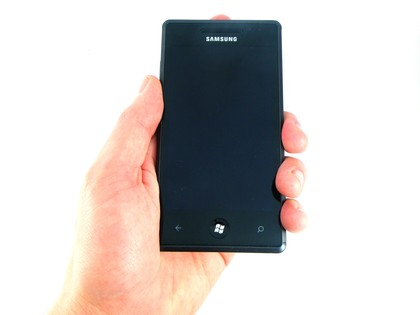TechRadar Verdict
The screen will be what sells the Samsung Omnia 7, but given the company's heritage in this arena we expected slightly more
Pros
- +
High quality screen
- +
Slick and reponsive interface
- +
Comfortable design
- +
Passable camera quality
- +
Cool gaming experience
Cons
- -
Cheap-feeling rear
- -
Slow internet browser with no Flash
- -
Mega-bright LED flash
- -
No worthwhile Samsung-added software on board
- -
Lack of microSD expansion
Why you can trust TechRadar
Samsung's take on Windows Phone 7 was always going to be tech-heavy – and that's proved to be the case.
Featuring a 4-inch Super AMOLED screen and a cool industrial design, the Samsung Omnia 7 is a slightly different take from the LG and HTC crowd.
It hasn't gone big on the camera side of things like the HTC 7 Mozart, packing only a 5-megapixel camera and a single LED flash.
But it's that screen that really makes things pop on this phone – it's almost like the feeling you get when you first see a Blu-ray on a proper HD telly: everything looks more real than reality itself.

Yes, we've seen the same things on the Samsung Galaxy S, but for some reason the angular design of Windows Phone 7 interface really brings out the deep contrast and vivid colours more than on the Android version.

The Samsung Omnia 7 is actually very similar in layout to the Galaxy S: the power/lock key is located on the right-hand side of the phone, where it's easy to access without having to jiggle the phone around in your hand too much. This is the same side as the small but easy to press camera button, which is staggered to help activate the autofocus, and is easy to use.

The top of the phone houses the ports – we're looking at a pretty basic 3.5mm headphone jack and a slider switch with small piece of plastic to uncover the micro-USB slot.
Sign up for breaking news, reviews, opinion, top tech deals, and more.

The uninspiring-looking camera is in the same place, although with the Omnia 7 the plastic back has been replaced with a Samsung Wave-a-like metallic option that we really like. You release this with a small switch at the bottom, and the cover simply pops up with no hassle.

The right-hand side of the phone has the volume keys, or up and down navigation, which is good if you're right-handed and use the phone for sports applications in the future, but feels less intuitive for volume adjustment during calls.

The Windows Phone 7 range has placed a real premium on the high-end feel of the handsets, and the Samsung Omnia is one of the best examples of this in our opinion.

The front keys are the most impressive – there's an iPhone 4-like main home key, which is circular and concave, and the two touch sensitive buttons surrounding it are very responsive.
However, they're hard to see when they're not lit up and in action, and can be hard to hit without looking.
We'd rather they were also slightly indented, because it would continue the premium feel across the front of the phone and stop the Samsung Omnia 7 looking like every other Windows Phone 7 handset.
Current page: Samsung Omnia 7: Overview, design and feel
Next Page Samsung Omnia 7: Interface
Gareth has been part of the consumer technology world in a career spanning three decades. He started life as a staff writer on the fledgling TechRadar, and has grew with the site (primarily as phones, tablets and wearables editor) until becoming Global Editor in Chief in 2018. Gareth has written over 4,000 articles for TechRadar, has contributed expert insight to a number of other publications, chaired panels on zeitgeist technologies, presented at the Gadget Show Live as well as representing the brand on TV and radio for multiple channels including Sky, BBC, ITV and Al-Jazeera. Passionate about fitness, he can bore anyone rigid about stress management, sleep tracking, heart rate variance as well as bemoaning something about the latest iPhone, Galaxy or OLED TV.
